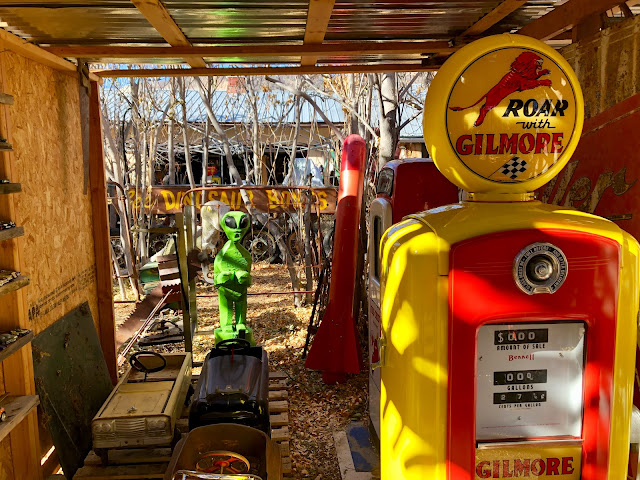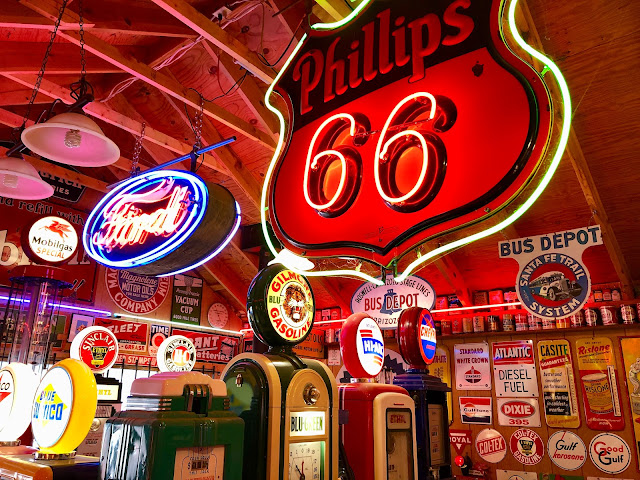On our New Mexico trip last December, that place was Embudo, New Mexico. Elevation 5,824 feet. Population 444. 18 acres in size. 43 miles mostly north from Santa Fe on the low road to Taos. Drive the speed limit and you'll get there in just a bit less than an hour. Embudo. Blink and you'll miss it. We didn't blink. We were not going to miss Embudo.
So what's in Embudo, you ask? Well maybe a better question is who's in Embudo. And the answer to that question is Johnnie Meier. Johnnie's the reason we visited Embudo.
Johnnie owns a place in Embudo along New Mexico Route 68 just across the road from the Rio Grande. Yes, the river the Rio Grande. Johnnie's place is a former gas station. A Frontier gas station, if I'm taking a guess based on the large advertising sign on the side of the road. His place is a single story building with three old gas pumps out front with the whole thing set back just far enough from the road for a car or truck to pull into the lot and fill up. Were the gas station still operational, that is. And when I say old gas pumps, I really do mean it. Like from a time before I was old enough to remember gas pumps that look quite like the Frontier models on Johnnie's lot.
The three pumps in front of the old building aren't the only old gas pumps on the lot. In fact, there might be a hundred or more hanging around in one spot or another, lined up and away from Route 68 or shoved under a shed roof attached to the station or just standing around the perimeter of the lot in rows of four or five. Some of these pumps remind me of what I first saw at gas stations when we moved to the United States in the late '70s: leaded and unleaded pumps with dials that clicked around showing the amount of fuel pumped and the total price to be paid. Others are clearly older than that, with clear cylinders on top of the body of the pump or circular signs that illuminate at night.
Johnnie Meier is a collector, which I totally respect (having the collecting gene myself). And what he collects is old gas station stuff. Pumps, signs (both neon and non-neon), oil cans, old maps, iceboxes, bottle openers, anything and everything that you might have found at one time at a gas station or service station. And a lot of it is all out there for anyone driving down Route 68 to pull over and have a look. How could there be anything much more intriguing, enticing or unique than this? Johnnie's Classical Gas Museum was a can't miss stop for me.
Now, if you know anything about me, it's if there's one thing that is a sure bet to draw me into somewhere, it's blatant American commercialism. I mean like mid-20th century over the top, as bright and colorful and loud and look at me as it can possibly be. The Classical Gas Museum has all that. It is striking to see it all set against the gorgeous New Mexico desert and mountains beyond. I think that contrast makes it better.
The collection of stuff (some, I'm sure would call it junk and they would be wrong for sure) on Johnnie's lot is truly impressive. Huge metal signs from old gas stations that no longer exist. Gorgeous old chrome plated gas pumps with not a spot of rust on them. Almost everything super clean and sparkling. Johnnie takes care of his collection. It helps I guess that his lot is in one of the driest places in the United States but the love in what's out on his lot shows. And he's willing to share with anyone for absolutely nothing. There's no admission to get onto the lot. Just wander on and start poking around. We spent maybe 20 minutes or so checking out everything we could and taking as many pictures as we wanted.
Then Johnnie showed up.
Now we'd get some insight into this collection.
Johnnie's been building his collection over about 30 years or so, ever since he got tired of restoring old automobiles and decided to direct his passion into something else. In winter, he gets maybe three cars a day pulling over to look at his collection. In summer, it surges to about 20 or so. Not a huge volume of people making the stop on the low road. It's not obvious that you should stop unless you know what's there.
Johnnie refers to the stuff we'd been ogling outside as his "rusty stuff". It's glorious. It really is. But the jewels of his museum are not outside. They are inside the old office of the gas station. Johnnie calls what's inside his "shiny stuff". And it blows what's outside away. No contest. You need to make sure you get a look inside. We didn't do anything to make sure Johnnie would be there when we were there (although honestly, I'd read that he's usually around on weekends). We wouldn't know what we'd missed if we hadn't gotten a look at his shiny stuff.
What is inside that old gas station building is just incredible.
I guess gas pumps used to have these glass globes on top of them that were lit up at night. At the Classical Gas Museum, they are lit up during the day. But only if you get inside the old building. The condition and variety of the collection that Johnnie has inside that place is astonishing. I mean just gorgeous, beautifully restored artifacts of a time now long gone. I don't know what his utility bills are like on days when he lights his whole collection up for people like me but it is a thing of wonder.
You will undoubtedly recognize some of the signs inside the place. Conoco. Chevron. Gulf. Phillips 66. Sinclair. The Mobil Pegasus that used to be the iconic symbol of that brand (go to Dallas and you'll see the Pegasus all over that city). All stuffed into a tiny space on the walls and hung from the ceiling but displayed perfectly.
There are also a lot of signs I didn't recognize. It's staggering how many gasoline brands there used to be out there and how American capitalism has dwindled that list down from a list of many to a precious few. Valley. Mutual. Frontier. Malco (the BEST logo, by the way). Magnolia. Knight. Walk through this museum and you'll spot many more, I'm sure.
I don't know what else to say about this place. Hopefully the pictures posted here speak volumes. I know they do for me. Johnnie Meier's place is quirky, obscure, over the top, absolutely completely unique and beautifully curated. From our talk while I was in the Museum, I know Johnnie is concerned about the legacy of this collection. This is every bit as important to preserve as any place documenting the history of the United States in the mid to late 20th century.
We visited a lot of sites in our week in New Mexico. I'm sure some of those like the Georgia O'Keeffe Museum and the ABQ Holiday Market and the Indian Pueblo Cultural Center draw a ton of visitors. Way more in a day than the Classical Gas Museum draws in a month or maybe three months or more. This place was every bit as good as all those other spots. Beyond the actual objects preserved on property, the care and love that Johnnie Meier shows for what's on his piece of land in Embudo is important and is so valuable.
And if you go, you are likely to be the only people in the place when you are there. There's a lot to be said for that.












